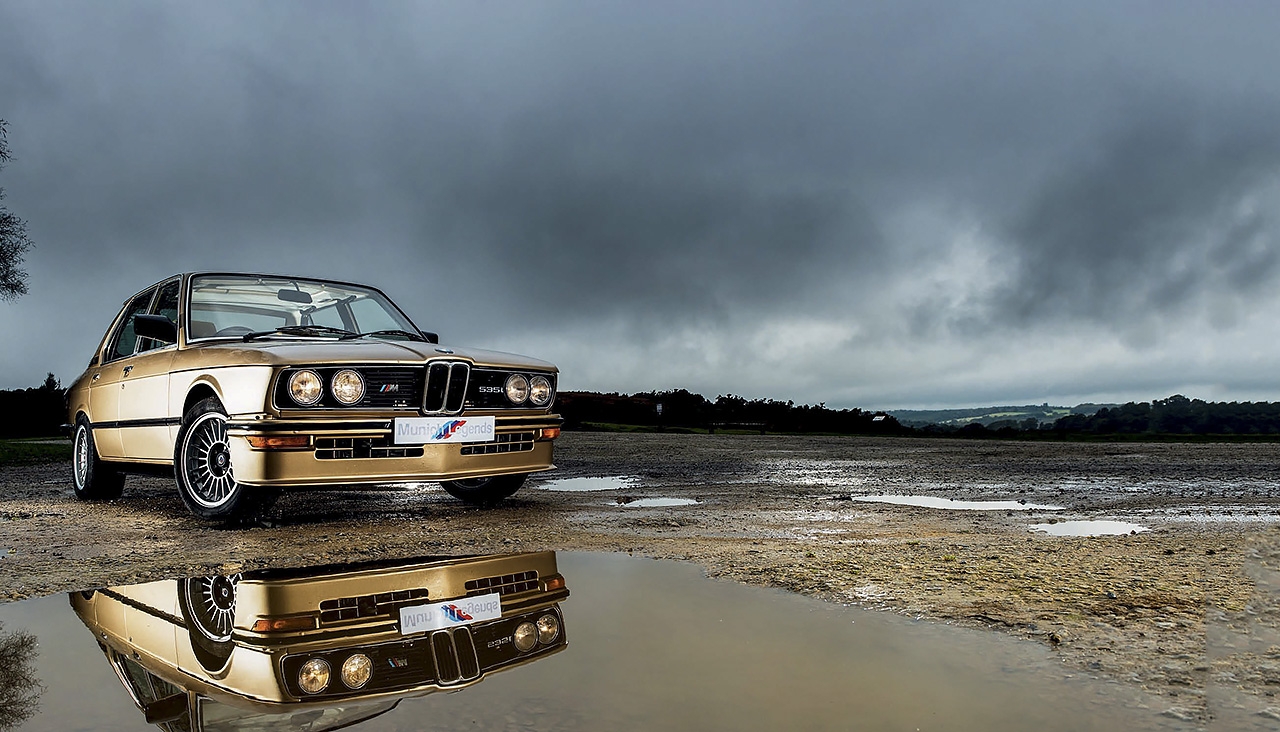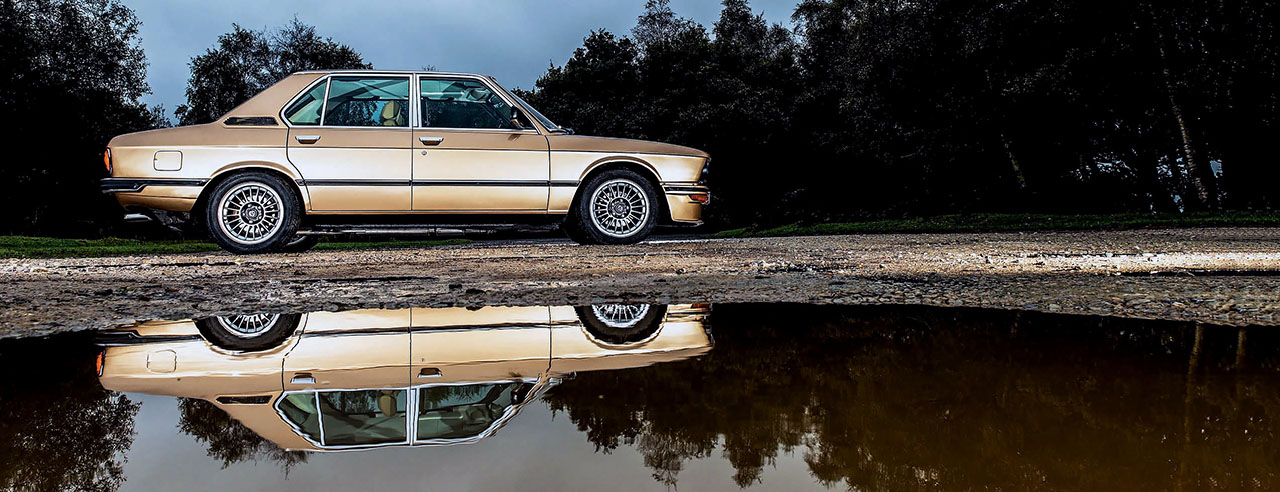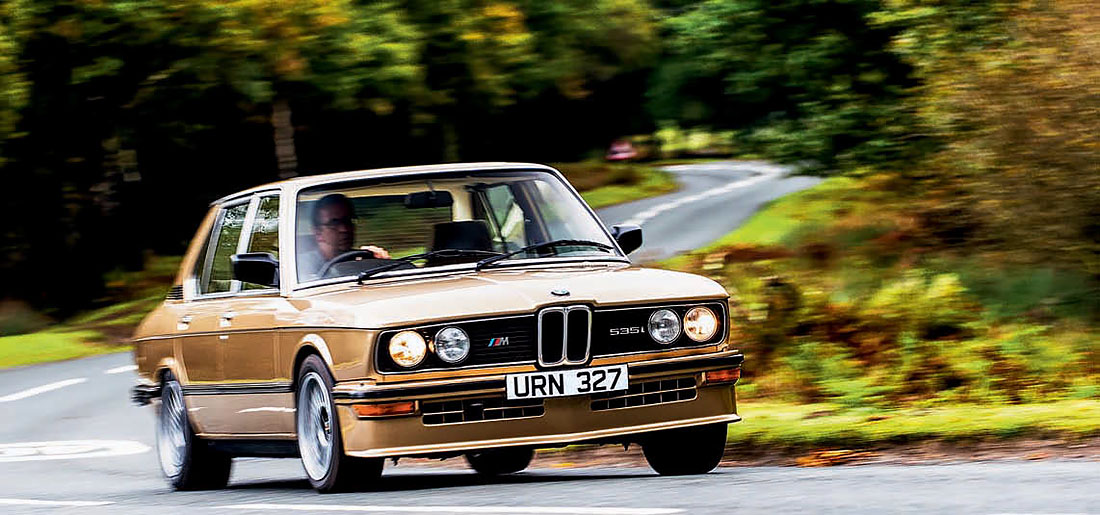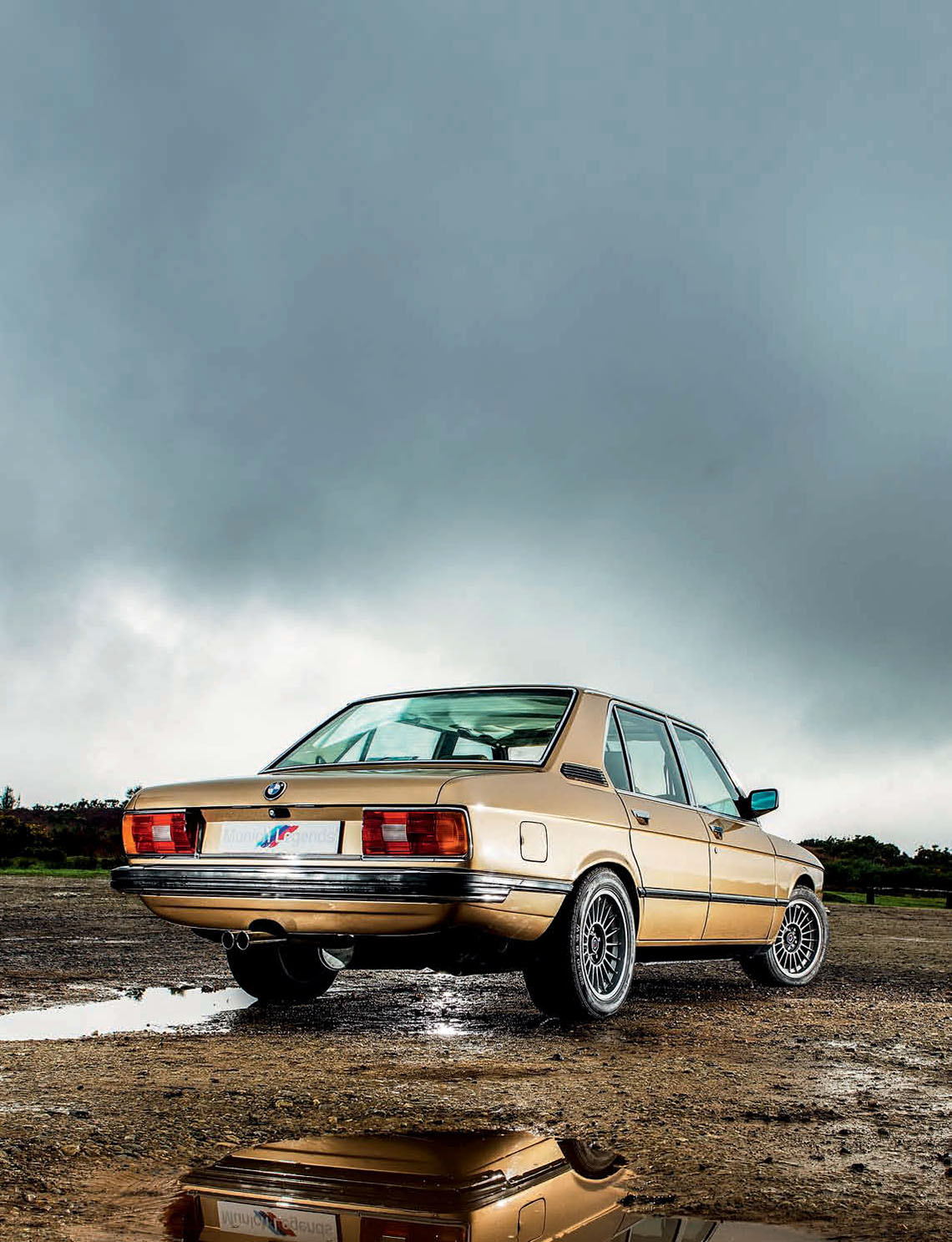
Gold Standard. The BMW E12 M535i is 35 years old so we take a look back at the icon using this stunning gold example. On the 35th anniversary of the production version of the M535i we take a fond look back at what was in its day the ultimate super saloon. Words: Bob Harper. Photography: Dave Smith.
Owning a reliable and accurate crystal ball would be an absolute godsend for those of us trying to work out what the next ‘Big Thing’ in the classic car world is likely to be. Reading the classified section of old back issues makes you want to weep as some machinery has gone up in value tenfold while others have more or less stagnated and are worth today what they were ten or 12 years ago. The main problem is that it seems to be virtually impossible to work out which ones will take off and which ones will remain firmly glued to the runway.

And the subject of today’s feature sits somewhere in no man’s land – it’s not quite taken off yet but we reckon, given time, that the E12 M535i must take its place at the high table of BMW icons alongside machinery such as the E30 M3 and M1. Admittedly both those machines have one crucial aspect that’s missing from the venerable E12 – a full-on multivalve M Power engine – but it has so much going for it that it seems criminal that it’s so often overlooked.
While I don’t want to be accused of talking up M car values to such an extent that they become unattainable for the majority of us enthusiasts, there is a problem when values are stuck in the doldrums – the cars end up being worth as much in bits as they do as a going concern – and owners tend to be reluctant to spend a fortune restoring the cars when they’re unlikely to ever get the money back when the time comes to sell it. Cheap M535is do come up for sale from time to time but we’d recommend buying a very usable machine like this car recently sold by Munich Legends. It’s not perfect but it certainly doesn’t need a thorough recommissioning either.
So why should the M535i E12 become a BMW icon? Well, to start with, it has rarity value in spades – just 1410 rolled off the German assembly lines – and while some additional models were manufactured in South Africa, right-hand drive production for the rest of the world was limited to just 450 examples. Rarity in itself doesn’t always lead to rarefied status though; there needs to be something else, and the E12 M535i has that too – it’s the great granddaddy of all generations of M5 and was the first M car to be conceived, designed and constructed wholly by BMW Motorsport. And surely the icing on the cake is the fact that it actually looks really rather cool, too.

The M535i’s cockpit wasn’t lavishly appointed but the superb Recaro seats gripped you in all the right places while the M1 steering wheel was very tactile.
Amazingly for a machine that still looks pretty fresh it’s now 35 years since the first examples started rolling down the 5 Series line at BMW’s Dingolfing before being plucked from the factory floor by Motorsport to be finished at its facility on the Preussenstrasse in Munich. There had been largeengined Fives before the M535i made its motor show debut at Frankfurt in 1979 as BMW had been quietly shoehorning big ‘sixes into E12 shells for favoured clients and BMW in South Africa had (in conjunction with BMW Motorsport in Germany) made the 530MLE in order for the car to be eligible for the 3.0-litre class in modified production class racing. But it wasn’t until 1980 that the masses (if you can call 1410 owners masses) could get their hands on the ultimate 5 Series.
At low revs it burbles away with a deep bassy growl, increasing in pitch and timbre as the revs climb.
And those owners would have needed to be wellheeled ones, as back in 1980 an M535i would have set you back £13,745 – which was less than you’d pay for the mechanically virtually identical 635CSi but £4000 more than a mildly sporting 2.8-litre Ford Granada or Opel Senator would have cost. You did, however, get plenty for your money with the BMW, at least in terms of hardware, as just about everything that could have been uprated for the M535i was. In the UK the hottest Five up until this point was the 528i and while it was no slouch, slotting the 218hp M30 ‘six from the 635CSi and 735i into the lighter E12 shell made the M535i an absolute flying machine. When Autocar tested one back in 1980 it recorded a 0-60mph time of 7.1 seconds and a top speed of 139mph and while those stats are now comfortably matched by a 2.0-litre diesel hatch, 35 years ago those sort of figures were pretty astonishing for what was still a hugely practical five-seater saloon.
| CAR |
BMW E12 M535i |
| ENGINE: | M30 straight-six, SOHC, 12-valve |
| CAPACITY: | 3453cc |
| MAX POWER:(DIN) | 218hp @ 5200rpm |
| MAX TORQUE: (DIN) | 224lb ft @ 4000rpm |
| 0-62MPH: | 7.2 seconds |
| TOP SPEED: | 138MPH |
| WEIGHT: | 1350kg |
| PRICE WHEN NEW: | £13,745 (1980) |
| NUMBER MADE: | 1410 |
And it wasn’t just the raw numbers that were inspiring as Munich’s straight-six made all the right noises, too, something that still holds true today and is immediately apparent as we pull away from Munich Legends’ forecourt in this car’s pleasingly period gold livery. At low revs it burbles away with a deep bassy growl, increasing in pitch and timbre as the revs climb until it takes on all of the aural characteristics you expect to hear from a BMW ‘six at full chat. It’s not quite as sensational as a full-on M Power unit but it’s not that far off, and in something like this E12 there is so much less in the way of sound deadening, far less than you get in today’s offerings, that you can really hear the noise properly. Adding power is all very well but it’s a complete waste of time if other areas of the car aren’t uprated to cope and this was where BWM Motorsport really hit the bull’s eye with a series of subtle but hugely effective modifications. As I’m piloting our test car to the photo location I’m immediately struck how it feels so much tighter and more-of-a-whole than any other E12 I’ve driven. There’s more heft and feel to the steering with a decent amount of chatter and feedback coming through that hugely evocative M1-style steering wheel.
A normal E12 feels positively prosaic in comparison, especially when you pitch one into a corner as there’s excessive body roll that can almost set up a corkscrewing feeling if you hit an undulation in the road surface mid-corner. The M535i is much more planted and that’s not just down to the more modern rubber and the bigger-than-standard Alpina rims that ‘our’ example is running on. There’s significantly more poise built into the chassis, less body roll and a greater resistance to understeer. We don’t go mad on the day of the shoot as the roads are damp and this car has just found a buyer so there’s a very real need to bring it back in one piece but it did, in its day, have a bit of a reputation for being tail happy and that still holds true today, especially if you don’t drive it properly. The semi-trailing arm rear suspension might have been honed for the M535i but it’ll still bite the unsuspecting but, if driven with respect, it is very controllable. Slow-in, fast-out is definitely the order of the day when driving one of these and so long as it’s treated thus you can cover ground very rapidly indeed. Pitch it into corners while still on the brakes or lift-off mid-corner and you’ll be looking at a recipe for disaster, particularly in the wet.

Chassis changes consisted of unique springs with Bilstein dampers and uprated anti-roll bars measuring 24mm and 18mm front and rear respectively. Wider BBS alloys measuring 6.5×14 inches were fitted as standard and these were equipped with 195/70 Michelin XWX tyres, which were considered to be very grippy rubber 35 years ago. A limited-slip differential was a standard fitment which gave better grip accelerating out of corners and allowed owners to delve more readily into the playful side of the M535i’s chassis. Despite the significant rise in performance the 528i’s braking setup was deemed to be adequate enough so the 280mm front disc diameter was retained although for the M535i those discs were 3mm thicker to better resist fade.
That was more or less it for hardware changes for the hottest of E12 Fives although those hoping for an automatic gearbox would have been disappointed – this was to be a driver’s car par excellence and, as a result, BMW deemed that the only transmission option for European cars was to be the Getrag closeratio five-speed unit with a ‘dog-leg’ change pattern. In normal use the ‘box actually works really well, although selecting first does initially take a bit of getting used to, especially in a right-hand drive machine (it always seems a more natural movement when in an E30 M3 with the same shift pattern as this). Once on the move, though, having second and third gears on the same plane is a real bonus when attacking a twisty back road.

Cosmetically there were a couple of external changes to the standard E12 shell for the M535i: a deep front spoiler that not only helped to reduce front end lift but also channelled air to the front brakes and a chunky black rubber spoiler sitting atop the bootlid, although this latter item is missing from this particular machine. Motorsport striping was an optional extra (and looked fantastic on white cars) while in some markets the M535i could also be spec’d without the spoilers for the super-stealthy look.
There was no mistaking the M535i’s sporting intent when you step into its cockpit, though, as the front armchairs you’d find in the rest of the range had been replaced by a pair of body-hugging, high-back Recaros clad in a corduroy-type material, although leather was also an opulent option for the last word on luxury. The only other change was the M1 steering wheel with its flat face and thicker-than-normal rim. It was also significantly smaller in diameter than the standard 5 Series steering wheel which, on some models, felt like it would have been more at home on the bridge of the QE2. Everything else is traditional BMW – the dash angled towards the driver, four plain but oh-so-clear dials and some natty detailing such as the digital clock sitting in the middle of the rotary fan switch. It’s a great place to spend wheel time and you can imagine stepping out after a cross-continent jaunt feeling fresh as a daisy.
Despite the inclement weather the M535i is still a hoot to punt around the back roads of Sussex – you can easily potter around in a high gear letting the torque take the strain as it’s really a very flexible engine, but once you’ve delved into the performance you’ll want to drive it harder to hear that peach of a ‘six strut its stuff and to see if you can tame a car that in its day did have a bit of a reputation for being a handful for the unwary.

It strikes a great balance between being compliant enough to cope with our sorry roads – even on its modern 16-inch wheel and tyre combination – yet there’s enough stability and poise to not feel like you have to tippy-toe around in these inclement conditions. For someone looking for a classic that can be enjoyed by all the family this really has to be a superb choice. The E12’s delicate lines are perfectly complemented by that front chin spoiler and while there’s far too much chrome to be a more modern design the shape of the E12 manages to appear both fresh yet retro at the same time.
True, some parts are becoming a little hard to get hold of but mechanically it’s a pretty simple piece of kit and far less complicated than a more modern M car to look after. No one can know exactly which machines will become coveted by collectors in the future but I’d argue that the E12 M535i really should be one of them. It has the looks, performance, useability and the heritage to sit up there with the best of them. Snap one up before it’s too late.
THANKS TO: Munich Legends Tel: 01825 740456 Web: munichlegends. co. uk





